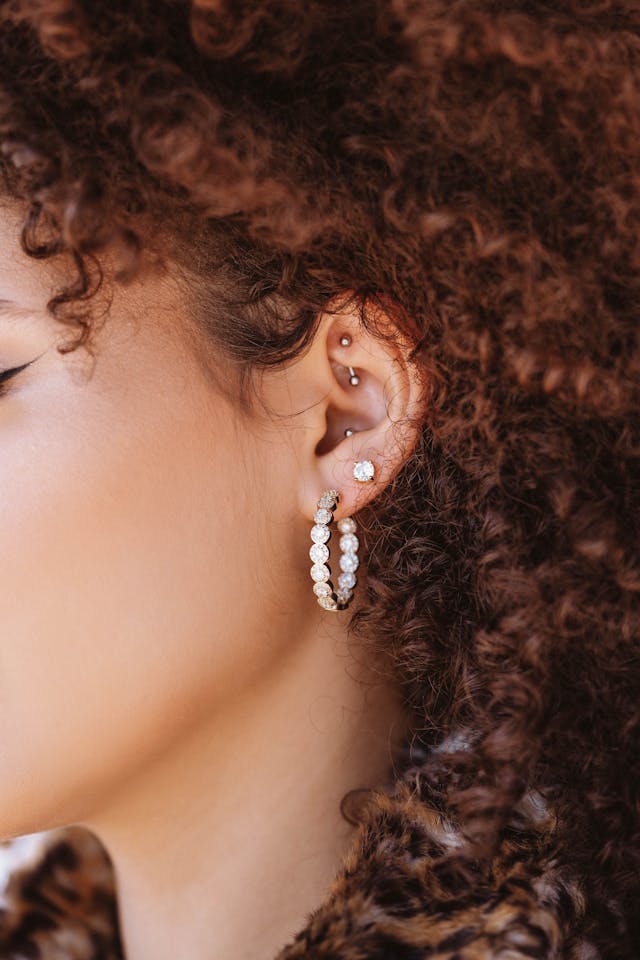Getting your ears pierced is an exciting experience, but it comes with some important aftercare considerations. One common question that often arises is, “Can you swim after getting ears pierced?” This article will dive deep into this topic, providing you with all the information you need to keep your new piercings safe and healthy.
Introduction
When you get your ears pierced, it’s natural to wonder how it might affect your daily activities, especially during the summer months when swimming is a popular pastime. Understanding the dos and don’ts of swimming after ear piercing is crucial for proper healing and avoiding complications.
Understanding Ear Piercings
Before we jump into the swimming question, let’s look at the different types of ear piercings and their healing times:
- Earlobe Piercings: These are the most common and typically heal the fastest, usually within 6-8 weeks.
- Cartilage Piercings: These include helix, tragus, and industrial piercings. They take longer to heal, often 4-6 months or more.
Knowing your piercing type and expected healing time is essential for making informed decisions about swimming and other activities.

Risks of Swimming After Ear Piercing
Infection Risks
Swimming too soon after getting your ears pierced can increase the risk of infection. Here’s why:
- Water can carry bacteria that may enter the piercing site.
- A fresh piercing is essentially an open wound, making it more susceptible to infection.
Watch out for these common symptoms of infection:
- Redness
- Swelling
- Pain
- Unusual discharge or pus
Impact of Water Types
Different types of water present varying levels of risk:
Chlorinated Pools
Many people believe that chlorine in pools kills all bacteria, making it safe for new piercings. However, this isn’t entirely true:
- While chlorine does kill some bacteria, it doesn’t eliminate all risks.
- Chlorine can also irritate fresh piercings, potentially slowing down the healing process.
Recommendations for pool swimming:
- Wait at least two weeks before swimming in a pool.
- Use a waterproof bandage to cover the piercing.
- Clean the piercing thoroughly after swimming.
Natural Bodies of Water
Swimming in lakes, rivers, or oceans can be riskier than pools:
- Natural water bodies contain various microorganisms that could lead to infection.
- Stagnant water, like in some lakes or ponds, can be particularly dangerous due to higher bacteria levels.
Important tip: Avoid swimming in natural bodies of water for at least 4-6 weeks after getting your ears pierced.
Recommended Timeframes for Swimming
Initial Waiting Period
The general recommendation is to avoid swimming for the first two weeks after getting your ears pierced. This allows the initial healing process to begin without interruption.
Post-Two Weeks Guidelines
After the initial two-week period, you can consider swimming based on the type of piercing:
- Earlobe piercings: You may be able to swim after 2-3 weeks, but it’s best to check with your piercer first.
- Cartilage piercings: Wait at least 4-6 weeks before swimming, and even then, take extra precautions.
Remember, everyone’s healing process is different. Always assess your individual healing progress and consult with a professional if you’re unsure.
Aftercare Tips for Swimming with New Piercings
If you decide to swim after the recommended waiting period, follow these tips to protect your piercings:
Pre-Swimming Preparations
- Use waterproof bandages: Cover your piercings with waterproof bandages designed for wound protection.
- Clean before swimming: Gently clean your piercings with a saline solution before entering the water.
Post-Swimming Care
- Immediate cleaning: As soon as you’re out of the water, clean your piercings thoroughly with a saline solution.
- Monitor for signs of infection: Keep a close eye on your piercings for any signs of irritation or infection in the days following your swim.
Conclusion
Understanding the dos and don’ts of swimming after getting your ears pierced is crucial for a healthy healing process. Here are the key takeaways:
- Wait at least two weeks before swimming, and longer for cartilage piercings.
- Different types of water pose varying risks – be extra cautious with natural bodies of water.
- Use proper protection like waterproof bandages when you do swim.
- Always clean your piercings before and after swimming.
- Monitor for signs of infection and seek help if you notice any unusual symptoms.
Remember, patience is key when it comes to ear-piercing aftercare. While it might be tempting to dive into the pool right away, giving your piercings time to heal properly will ensure you can enjoy both your new look and your favorite water activities in the long run.
By following these guidelines and listening to your body, you can safely navigate the question “Can you swim after getting ears pierced.” When in doubt, always consult with your piercer or a healthcare professional. Happy swimming, and enjoy your new piercings!
Frequently Asked Questions (FAQs)
Can I swim in a pool after getting my ears pierced?
It’s best to wait at least two weeks before swimming in a pool after getting your ears pierced. Chlorinated water can irritate fresh piercings and potentially slow down the healing process. After the initial two-week period, you can consider swimming with proper protection, such as waterproof bandages. However, for cartilage piercings, it’s advisable to wait 4-6 weeks or longer.
What should I do if I accidentally swim with a new piercing?
If you accidentally swim with a new piercing, don’t panic. Follow these steps:
- Rinse the piercing thoroughly with clean, fresh water.
- Clean the area with a saline solution as soon as possible.
- Gently pat the area dry with a clean paper towel.
- Monitor the piercing closely for the next few days for any signs of infection.
- If you notice any unusual symptoms, consult your piercer or a healthcare professional.
How can I protect my piercing while swimming?
To protect your piercing while swimming:
- Use a waterproof bandage to cover the piercing.
- Apply a thin layer of petroleum jelly around the bandage edges to create an additional waterproof seal.
- Avoid touching or adjusting the bandage while in the water.
- Remove the bandage and clean the piercing immediately after swimming.
- Consider wearing a swim cap if you have cartilage piercings.
What are the signs of infection I should watch for?
Be alert for these signs of infection:
- Increased redness or swelling around the piercing site
- Persistent pain or tenderness
- Unusual discharge, especially if it’s yellow, green, or has an unpleasant odor
- Fever or chills
- The jewelry feels too tight or embedded in the skin
If you experience any of these symptoms, seek medical attention promptly.

[…] Avoid Swimming: Stay out of pools, hot tubs, and oceans until your piercing is fully healed to avoid introducing bacteria to the area. […]